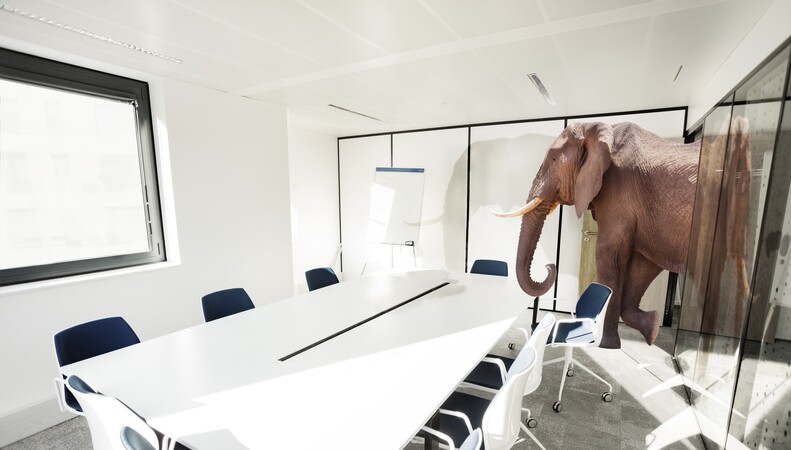The working world is still figuring out what it means to ‘work well’.
One of the most pressing organisational challenges is the growing divide between executive leadership and the broader workforce on the issue of flexibility.
Often, this ‘elephant in the room’ stems from a mismatch in expectations, values, and lived realities between the C-suite and employees when it comes to how, when, and where work should happen.
As businesses scramble to redefine their office policies, many are struggling to bridge this critical gap.
If left unresolved, this misalignment can erode trust, stall progress in adaptive organisations, and, importantly, lead to resignations.
58% of UK employees stated they would quit or seek new jobs if forced to return five days a week.
So how can businesses fix the flexibility elephant? It requires more than policy memos or one-size-fits-all mandates; it demands cultural realignment, open dialogue, and shared accountability.
Why The Flexible Working Divide Exists
During the COVID-19 pandemic, remote and hybrid work models emerged as both a necessity and a revelation. Many workers demonstrated that they could be just as productive, if not more so, outside the traditional office.
The experience empowered employees to expect more autonomy, not just in terms of location, but also in how they manage their time and balance their lives.
Meanwhile, many executives experienced the shift to hybrid working differently. C-suite leaders have often maintained access to private offices, strong support networks, and greater autonomy over their schedules.
And many are worried that flexibility undermines control, team cohesion, and the spontaneous interactions they believe drive innovation and influence. In essence, it asks the question: Can I still manage well?
72% of executives feel they can negotiate their flexible work arrangements with their managers, compared to only 50% of employees who feel they have that same privilege.
The contrast underscores how the benefits of returning to the office - including visibility, influence, and high-touch resources - disproportionately favour those already at the top.
How C-Suite and Employees Experience Hybrid Work Differently
To highlight this divide between the C-suite and other workers’ experience, research firm Gartner conducted a survey of 4,000 employees, ranging in seniority. Their report found key discrepancies between executive leaders and the rest of the organisation, including:
Employees didn't think there was a culture of flexibility, but executives did
Executives are more equipped to work remotely than employees
Employees are more concerned about executives not acting in their interest
Executives believe they listen well - the majority of employees don't agree
Executives feel a greater purpose in the organisation.
It’s clear that those in the C-suite or more executive roles often experience a different version of office work than other employees.
And with return-to-office (RTO) discussions taking centre stage in 2023 and 2024, the divergence is becoming more crystallised. Executives, citing concerns about culture, innovation, and mentorship, began issuing top-down directives to bring employees back into physical offices.
But for much of the workforce, these decisions felt disconnected and tone-deaf. The elephant grew.

Flexibility vs Control: What the C-Suite and Employees Really Value
One of the core tensions lies in how flexibility is perceived. For many executives, returning to the office is about preserving organisational culture and maintaining control over operations. Some believe that physical proximity is key to this.
For employees, however, flexibility is about trust and quality of life. It represents a reimagined social contract in which individuals are evaluated on output, not face time. The insistence on physical presence often reads as a lack of trust or an outdated view of productivity.
This clash reveals a broader identity crisis: Are companies defined by shared physical spaces or by shared values, outcomes, and goals? The truth likely lies in a hybrid of both, but the path to balance remains elusive.
Scott Farquhar, Co-CEO of Atlassian, says on work flexibility:
“We expect people to be able to work from home, from a café, from an office, but we don’t really care where they do their work - what we care about is the output that they produce.”
Another reality to consider is that different sectors require a different balance of the working qualities mentioned above.
For example, the technology sector widely embraces remote and asynchronous work to drive innovation and attract talent, whereas finance tends to adopt hybrid models more cautiously, balancing flexibility with regulatory and security concerns.
Creative agencies, on the other hand, often offer high autonomy, flexible hours, and remote options to support creative flow and client demands. Each industry needs to tailor flexibility to align with its unique priorities and work dynamics.
Why Data Only Tells Half The Flexible Work Story
Numerous studies have highlighted the productivity and satisfaction benefits of flexible work. For example, surveys consistently show that employees with more autonomy report higher engagement and lower burnout.
Yet, despite the data, many CEOs and executives remain sceptical. Some argue that what looks like short-term productivity gains may erode over time if employees disconnect from organisational culture.
There’s also a critical difference in what “flexibility” actually means. For office knowledge workers, it may mean remote work. For frontline workers, it could mean better shift scheduling or more predictable hours. But too often, executive decisions about flexibility are made with a narrow, homogeneous view of the workforce, typically reflecting the reality of the executive tier itself.
In a recent LinkedIn survey conducted by Freshminds, employees were asked about preferred flexible working models. The survey found that both Flexitime / 4-day work weeks (33%) and Work-from-anywhere models (45%) were by far the most popular.
This proves the true nuance across employees' needs. To bridge the gap, organisations need to disaggregate their workforce data and listen deeply across all levels and roles.
Executive Behaviour Shaping Flexible Work Culture
One of the most powerful ways to address the flexibility divide is through leadership modelling. When executives preach flexibility but are constantly seen in the office, working long hours, or rewarding presenteeism, it sends mixed signals. Conversely, when leaders openly embrace flexible models, logging off early for personal commitments or working remotely themselves, they give implicit permission for others to do the same.
The reality is that many senior leaders achieved their positions in a world where visibility equalled value. Their instincts and success were built in an office-first culture. Asking them to champion flexible models is asking them to question the very conditions that led to their rise.
It's not just a logistical shift; it's a psychological one.
Organisations must support executives in this transition, helping them unlearn legacy habits and redefine what leadership looks like in a flexible future.
How Can the C-Suite Rebuild Trust With Employees?
Ultimately, the flexibility elephant is a symptom of a deeper issue: a fractured psychological contract between employers and employees.
In the traditional model, workers offered loyalty and time in exchange for stability and growth. Today’s workforce demands a different exchange - one rooted in trust, autonomy, and purpose.
To rebuild this contract, organisations must:
Listen actively: Use pulse surveys, focus groups, and open forums to understand what employees truly value in flexibility.
Co-create solutions: Involve employees in designing policies and pilots, not just reacting to them.
Train managers: Equip company leaders with the tools to lead distributed and flexible teams effectively.
Redefine performance: Shift from time-based metrics to outcomes-based evaluation.
Prioritise equity: Ensure flexibility policies are inclusive across roles, seniority, and demographics.
What’s Next for Workplace Flexibility?
Flexibility is an ongoing negotiation. As technology evolves and societal expectations shift, so too must organisational norms. What's "flexible" today may feel rigid tomorrow.
To stay adaptive, companies should build feedback loops into their flexibility strategies, allowing them to course-correct in real time. Equally, flexibility should be treated not as a perk or policy but as a core component of organisational design and employee experience.
The companies that succeed won't be those with the strictest rules or the fanciest offices. They'll be the ones who foster cultures of trust, empower their people, and embrace change together.
The elephant in the room is big, but it's not immovable. With empathy, clarity, and courage, it can be transformed from an obstacle into a bridge.







